Fire in the City by Martines; Martines Lauro;

Author:Martines; Martines, Lauro;
Language: eng
Format: epub
Publisher: Oxford University Press USA - OSO
Published: 2006-02-18T16:00:00+00:00
Fighting Back
POPE ALEXANDER AND his advisers had been careful. The excommunication stated that the Friar was ‘suspected of heresy’. It did not charge him with the crime; doing so would have required an investigation and a trial. The Curia knew all about observing legal procedures, and also about appearing to observe them.
With some in Florence delighted by the anathema, and others angered by it, the city was now more divided than ever, particularly since the Mad Dogs (the Arrabbiati) had the document immediately translated from the Latin into Italian and rushed into print for widespread distribution. The clash was above all a battle of words, as each side jockeyed to win support and to defame or discredit the other. Divisions even in March had already been so acrimonious that the government had assembled the leaders of the main factions, twelve men in all, to have them try to reach some kind of harmony, beginning with peace among themselves. Another attempt at an amicable solution was made in June, but this too ended in failure. No agreement could be reached on the question of what to do about Savonarola, and leaders were also divided by the dispute over France versus the Holy League. Inevitably, too, loquacious Florence was treated to some insulting anonymous sonnets, penned against the Friar and his Piagnoni. Even pictures were thrown about, showing Savonarola in obscene dress or a lurid stance of some sort – an image surely to be counted among the first cartoons in the history of Europe.
The Friar’s enemies in Florence always claimed that he had single-handedly divided the city and filled it with discord. This take on events was both true and false. The false part was in the suggestion that Florence’s deep schisms were about the man, rather than about politics, issues, and ideas – an analysis, in short, that was no analysis at all but rather gross oversimplification. In the course of 1495, the Friar became the most fearless and important defender of the new republic, with the Great Council as its foundation block and the chief magistracies – Signory, Ten, and Eight – now rendered more responsible to an electorate, thanks to the eyes and electoral input of the Council. But his charisma and his ability to hold the rapt attention of up to 15,000 listeners had also turned him into an icon: a figure whose aura seemed to resolve or simplify the burning questions that swirled around him. We may assume, however, that political leaders – Pierfilippo Pandolfini, Bernardo del Nero, Paolantonio Soderini, Francesco Valori, Bernardo Rucellai, and the rest – never lost sight of the realities of politics, and this also meant using the Friar as an icon, whether to win support or to direct hostility against him and the Savonarolans. The most controversial of men could thus be blamed for everything, at the same time that he was being used to promote or to attack policies that would still be very much there long after he had vanished from the scene.
Download
This site does not store any files on its server. We only index and link to content provided by other sites. Please contact the content providers to delete copyright contents if any and email us, we'll remove relevant links or contents immediately.
| Ancient & Classical | Arthurian Romance |
| Beat Generation | Feminist |
| Gothic & Romantic | LGBT |
| Medieval | Modern |
| Modernism | Postmodernism |
| Renaissance | Shakespeare |
| Surrealism | Victorian |
4 3 2 1: A Novel by Paul Auster(11788)
The handmaid's tale by Margaret Atwood(7446)
Giovanni's Room by James Baldwin(6806)
Asking the Right Questions: A Guide to Critical Thinking by M. Neil Browne & Stuart M. Keeley(5355)
Big Magic: Creative Living Beyond Fear by Elizabeth Gilbert(5350)
Ego Is the Enemy by Ryan Holiday(4953)
On Writing A Memoir of the Craft by Stephen King(4659)
The Body: A Guide for Occupants by Bill Bryson(4579)
Ken Follett - World without end by Ken Follett(4441)
Bluets by Maggie Nelson(4258)
Adulting by Kelly Williams Brown(4231)
Eat That Frog! by Brian Tracy(4147)
Guilty Pleasures by Laurell K Hamilton(4115)
White Noise - A Novel by Don DeLillo(3828)
The Poetry of Pablo Neruda by Pablo Neruda(3813)
Fingerprints of the Gods by Graham Hancock(3731)
Alive: The Story of the Andes Survivors by Piers Paul Read(3726)
The Book of Joy by Dalai Lama(3693)
The Bookshop by Penelope Fitzgerald(3615)
